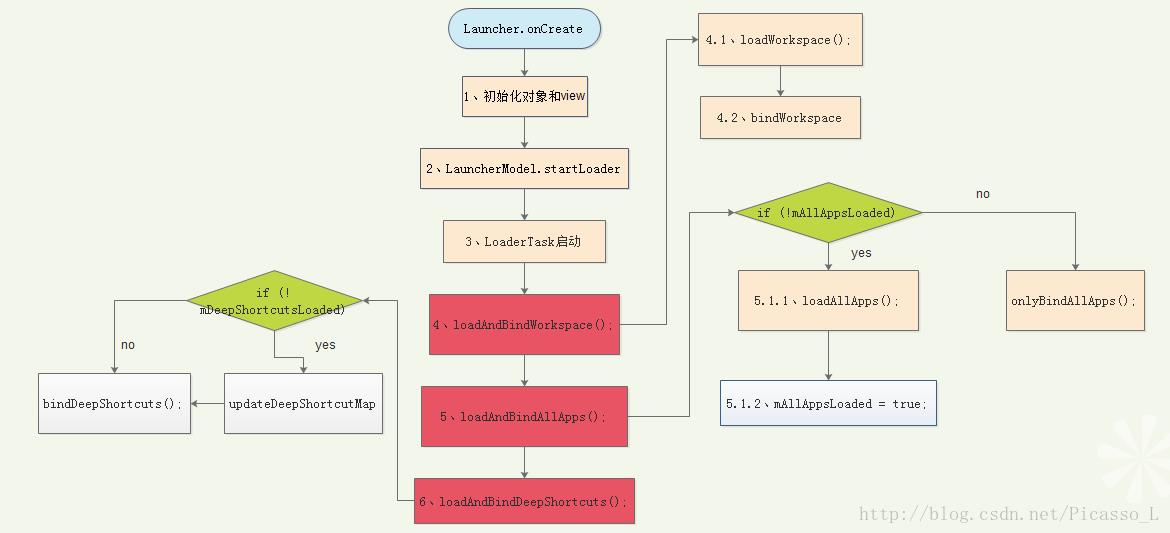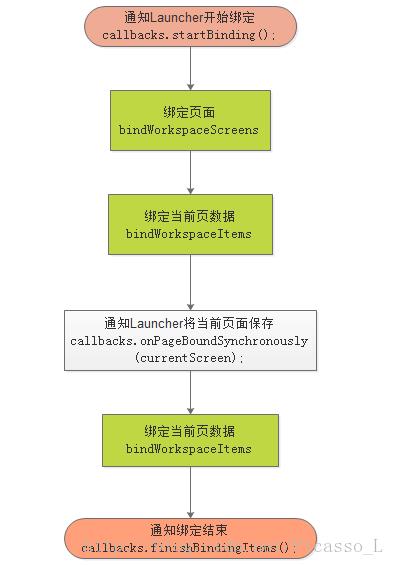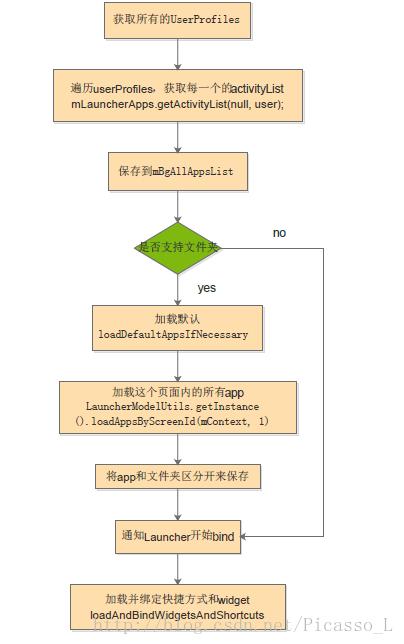android7.x Launcher3源码解析---workspace和allapps加载流程
Posted Picasso_L
tags:
篇首语:本文由小常识网(cha138.com)小编为大家整理,主要介绍了android7.x Launcher3源码解析---workspace和allapps加载流程相关的知识,希望对你有一定的参考价值。
Launcher系列目录:
一、android7.x Launcher3源码解析(1)—启动流程
二、android7.x Launcher3源码解析(2)—框架结构
三、android7.x Launcher3源码解析(3)—workspace和allapps加载流程
前两篇博客分别对Lancher的启动和Launcher的框架结构进行了一些分析,这一篇,将着重开始分析界面的加载流程。
1、整体流程
先上一张整体的流程图吧。(图片看不清可以下载下来看或者右击新开个页面查看图片)

先从Launcher.java的onCreate方法开始,
protected void onCreate(Bundle savedInstanceState) {
......
//建立LauncherAppState对象
LauncherAppState.setApplicationContext(getApplicationContext());
LauncherAppState app = LauncherAppState.getInstance();
......
//建立LauncherModel对象
mModel = app.setLauncher(this);
//一些其他对象初始化
......
setContentView(R.layout.launcher);
setupViews();
if (!mRestoring) {
if (DISABLE_SYNCHRONOUS_BINDING_CURRENT_PAGE) {
// If the user leaves launcher, then we should just load items asynchronously when
// they return.
mModel.startLoader(PagedView.INVALID_RESTORE_PAGE);
} else {
// We only load the page synchronously if the user rotates (or triggers a
// configuration change) while launcher is in the foreground
mModel.startLoader(mWorkspace.getRestorePage());
}
}
......
}重点调用了LauncherModel的startLoader的方法,startLoader里面,最重要的就是启动了LoaderTask,mLoaderTask = new LoaderTask(mApp.getContext(), synchronousBindPage);
我们接着分析LoaderTask的run方法。
public void run() {
......
keep_running: {
if (DEBUG_LOADERS) Log.d(TAG, "step 1: loading workspace");
loadAndBindWorkspace();
if (mStopped) {
break keep_running;
}
waitForIdle();
// second step
if (DEBUG_LOADERS) Log.d(TAG, "step 2: loading all apps");
loadAndBindAllApps();
waitForIdle();
// third step
if (DEBUG_LOADERS) Log.d(TAG, "step 3: loading deep shortcuts");
loadAndBindDeepShortcuts();
}
......
}这里一共就几步,loadAndBindWorkspace–>waitForIdle()—>loadAndBindAllApps()—>waitForIdle()—>loadAndBindDeepShortcuts()
3步加载流程里面都穿插了waitForIdle,这个方法是干嘛的呢?
private void waitForIdle() {
......
synchronized (LoaderTask.this) {
final long workspaceWaitTime = DEBUG_LOADERS ? SystemClock.uptimeMillis() : 0;
mHandler.postIdle(new Runnable() {
public void run() {
synchronized (LoaderTask.this) {
mLoadAndBindStepFinished = true;
if (DEBUG_LOADERS) {
Log.d(TAG, "done with previous binding step");
}
LoaderTask.this.notify();
}
}
});
while (!mStopped && !mLoadAndBindStepFinished) {
try {
// Just in case mFlushingWorkerThread changes but we aren't woken up,
// wait no longer than 1sec at a time
this.wait(1000);
} catch (InterruptedException ex) {
// Ignore
}
}
......
}
}load数据时我们是去UI线程中处理的,UI线程正常情况下是不能阻塞的,否则有可能产生ANR,这将严重影响用户体验。所有这里LoaderTask在将结果发送给UI线程之后,为了保证界面绑定任务可以高效的完成,往往会将自己的任务暂停下来,等待UI线程处理完成。
分析下这个方法:
首先,创建一个UI线程闲时执行的任务,这个任务负责设置某些关键的控制标志,并将其通过PostIdle方法加入处理器的消息队列中。一旦任务得到执行,就会将mLoadAndBindStepFinished 置为true,以控制即将来临的有条件的无限等待。 最后 设置一个有条件的无限等待,等待来自UI线程的指示。
2、workspace的加载流程
从总流程图上可以看到,workspace的加载流程主要分为loadWorkspace();和bindWorkspace(mPageToBindFirst);
a、loadWorkspace()
loadWorkspace()的代码实在是太多了,这里就不全部贴出来了,主要功能就是负责从数据库表中读取数据并转译为Launcher桌面项的数据结构。
以下为步骤:
1、进行一些预处理
2、加载默认值
LauncherAppState.getLauncherProvider().loadDefaultFavoritesIfNecessary()之前Launcher2的loadDefaultFavoritesIfNecessary这个方法,是这样加载默认布局的:
workspaceResId = sp.getInt(DEFAULT_WORKSPACE_RESOURCE_ID, R.xml.default_workspace);但是Launcher3中,是这样加载的:
int workspaceResId = partnerRes.getIdentifier(Partner.RES_DEFAULT_LAYOUT,
"xml", partner.getPackageName());这个地方,我暂时还没理解,到底默认布局是哪个?
3、初始化数据
清空之前的内存数据
/** Clears all the sBg data structures */
private void clearSBgDataStructures() {
synchronized (sBgLock) {
sBgWorkspaceItems.clear();
sBgAppWidgets.clear();
sBgFolders.clear();
sBgItemsIdMap.clear();
sBgWorkspaceScreens.clear();
}
}4、查询ContentProvider,返回favorites表的结果集
final HashMap<String, Integer> installingPkgs = PackageInstallerCompat
.getInstance(mContext).updateAndGetActiveSessionCache();
final ArrayList<Long> itemsToRemove = new ArrayList<Long>();
final ArrayList<Long> restoredRows = new ArrayList<Long>();
final Uri contentUri = LauncherSettings.Favorites.CONTENT_URI;
if (DEBUG_LOADERS) Log.d(TAG, "loading model from " + contentUri);
final Cursor c = contentResolver.query(contentUri, null, null, null, null);5、根据不同的类型,将数据保存到对应的arrayList中。
类型包含下面这几种:
ITEM_TYPE_APPLICATION
ITEM_TYPE_SHORTCUT
ITEM_TYPE_FOLDER
ITEM_TYPE_APPWIDGET
ITEM_TYPE_CUSTOM_APPWIDGET根据以上类型,将数据保存到一下全局变量里面
sBgItemsIdMap,sBgWorkspaceItemsm,sBgAppWidgets,sBgFolders
另外,如果有空的文件夹、空的屏幕,也会delete掉,最终,把所有屏幕加载进全局变量sBgWorkspaceScreens中。
......
// Remove any empty folder
for (long folderId : LauncherAppState.getLauncherProvider()
.deleteEmptyFolders()) {
sBgWorkspaceItems.remove(sBgFolders.get(folderId));
sBgFolders.remove(folderId);
sBgItemsIdMap.remove(folderId);
}
......
sBgWorkspaceScreens.addAll(loadWorkspaceScreensDb(mContext));
// Remove any empty screens
ArrayList<Long> unusedScreens = new ArrayList<Long>(sBgWorkspaceScreens);
for (ItemInfo item: sBgItemsIdMap) {
long screenId = item.screenId;
if (item.container == LauncherSettings.Favorites.CONTAINER_DESKTOP &&
unusedScreens.contains(screenId)) {
unusedScreens.remove(screenId);
}
}
// If there are any empty screens remove them, and update.
if (unusedScreens.size() != 0) {
sBgWorkspaceScreens.removeAll(unusedScreens);
updateWorkspaceScreenOrder(context, sBgWorkspaceScreens);
}b、bindWorkspace
bindWorkspace的功能是将上面获取到的数据由Launcher显示出来。
步骤:
1、首先复制数据:
synchronized (sBgLock) {
workspaceItems.addAll(sBgWorkspaceItems);
appWidgets.addAll(sBgAppWidgets);
orderedScreenIds.addAll(sBgWorkspaceScreens);
folders = sBgFolders.clone();
itemsIdMap = sBgItemsIdMap.clone();
}2、装载数据并排序
//装载桌面项数据
filterCurrentWorkspaceItems(currentScreenId, workspaceItems, currentWorkspaceItems,
otherWorkspaceItems);
//装载widget
filterCurrentAppWidgets(currentScreenId, appWidgets, currentAppWidgets,
otherAppWidgets);
//装载文件夹
filterCurrentFolders(currentScreenId, itemsIdMap, folders, currentFolders,
otherFolders);
//排序
sortWorkspaceItemsSpatially(currentWorkspaceItems);
sortWorkspaceItemsSpatially(otherWorkspaceItems);
3、开始绑定

就上个流程图吧。
3、应用程序apps的加载
加载apps的主要流程,最上面那张流程图已经给出了,如果所有app没有加载,则loadAllApps();,不然直接onlyBindAllApps();
1、loadAllApps()

根据代码,画了下流程图,但是我不明白userProfile是个什么鬼?
2、onlyBindAllApps()
这里的函数比绑定workspace简单多了,直接通知Launcher绑定
Runnable r = new Runnable() {
public void run() {
final long t = SystemClock.uptimeMillis();
final Callbacks callbacks = tryGetCallbacks(oldCallbacks);
if (callbacks != null) {
callbacks.bindAllApplications(list);
callbacks.bindAllPackages(widgetList);
}
if (DEBUG_LOADERS) {
Log.d(TAG, "bound all " + list.size() + " apps from cache in "
+ (SystemClock.uptimeMillis()-t) + "ms");
}
}
};看一下Launcher的bindAllApplications函数,当然这个函数在loadAllApps函数里面也有,就是如何绑定数据来显示呢?
Launcher.java的bindAllApplications函数里面会给AllAppsContainerView设置数据
if (mAppsView != null) {
mAppsView.setApps(apps);
}再跟代码到AllAppsContainerView,
public void setApps(List<AppInfo> apps) {
mApps.setApps(apps);
}这个apps在哪里用到呢?比较明显的就是onFinishInflate()函数,
.....
// Load the all apps recycler view
mAppsRecyclerView = (AllAppsRecyclerView) findViewById(R.id.apps_list_view);
mAppsRecyclerView.setApps(mApps);
mAppsRecyclerView.setLayoutManager(mLayoutManager);
mAppsRecyclerView.setAdapter(mAdapter);
mAppsRecyclerView.setHasFixedSize(true);
.....设置给了recyclerView,很显然,Launcher的应用程序界面就是一个自定义的RecyclerView,给这个recyclerview绑定的adpter是AllAppsGridAdapter,看一下这个adpter的onCreateViewHolder函数,很明显,这里根据不同的类型加载了不同的布局(应用程序界面有app和文件夹,头上还有个搜索框,用recyclerview的这个功能是最容易实现的),关于Recyclerview如何可以根据不同的类型加载不同的布局,可以参考我很久之前写的博客 RecyclerView的不同position加载不同View实现。
好了,Launcher3的workspace和应用程序apps的加载流程就讲到这,后面还会对Launcher里面的内容做具体的分析。
以上是关于android7.x Launcher3源码解析---workspace和allapps加载流程的主要内容,如果未能解决你的问题,请参考以下文章